Special Feature: Products Sally Recommends
Première Bordeaux - Lundi matin
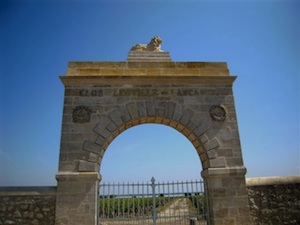 The Saturday tour of the city had been quite interesting. It was European, yes, but not nearly as magnificent as Paris. Sunday was their “Labor Day,” with even the mass transit operators on holiday. So, I stayed in the room and composed the Forward to this series of articles. The rest was needed. When Monday’s early morning alarm sounded, I was ready to get rolling. There were four stops, the first of which was scheduled for 9 am. in Saint-Julien. My coordinates had been checked during the first visit to the left-bank, so nerves had settled. Ms. Garmin did not take me onto the Loop, as she had previously. Presumably traffic issues at that time of the morning, the reason. We had a single minor transit problem. One of the highways along the route was closed due to roadwork, so she calculated an amusing alternate route that took me onto a paved road with room enough for only one and a half cars to travel. Thus oncoming traffic was a challenge. The French do not budge to the right shoulder until seconds before impact. The chess game (so to speak) was interesting. None of them expected to confront this crazy American road-warrior so early in the morning.
The Saturday tour of the city had been quite interesting. It was European, yes, but not nearly as magnificent as Paris. Sunday was their “Labor Day,” with even the mass transit operators on holiday. So, I stayed in the room and composed the Forward to this series of articles. The rest was needed. When Monday’s early morning alarm sounded, I was ready to get rolling. There were four stops, the first of which was scheduled for 9 am. in Saint-Julien. My coordinates had been checked during the first visit to the left-bank, so nerves had settled. Ms. Garmin did not take me onto the Loop, as she had previously. Presumably traffic issues at that time of the morning, the reason. We had a single minor transit problem. One of the highways along the route was closed due to roadwork, so she calculated an amusing alternate route that took me onto a paved road with room enough for only one and a half cars to travel. Thus oncoming traffic was a challenge. The French do not budge to the right shoulder until seconds before impact. The chess game (so to speak) was interesting. None of them expected to confront this crazy American road-warrior so early in the morning.
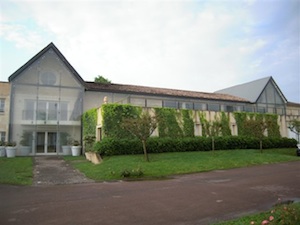 A half hour before my appointment, I pulled into the visitor’s parking lot of second-growth Chateau Leoville Poyferré. The facility was quite new in appearance, as if recently remodeled with modern Architectural features, including stone and glass components which blended into the surrounding community. Once a part of the grand Leoville las Cases estate in the 17th and 18th centuries, segmentation of the property was inevitable as the Marquis de Las-Cases-Beauvoir fled France during the French Revolution. The new government attempted to take over this wine property, but later as the new order settled into a form of organized government, it was successfully reclaimed. One parcel was sold in 1815, becoming Chateau Leoville Barton, and by 1840, the Marquis’ son Pierre-Jean had inherited most of the remaining estate, except for a smaller parcel which went to his sister Jeanne. She later married Baron Jean-Marie de Poyferré and the lineage of this new wine estate was established. Under this family’s ownership it earned the heralded second-growth certification in 1855. The property changed ownership again shortly thereafter, but by the turn of the century it was in the hands of a family of négociants named Cuvelier. In 1979, control of the property was taken over by one of their descendants named Didier CUVELIER. He has been responsible for changing Poyferré into the powerhouse winery that it is today. Through acquisitions the estate increased to a size of 80 hectares, planted with 65% Cabernet Sauvignon, 25% Merlot and the remaining 10% in Petit Verdot and Cabernet Franc. To my great fortune, it was Didier who personally took me on a VIP tour of the facility.
A half hour before my appointment, I pulled into the visitor’s parking lot of second-growth Chateau Leoville Poyferré. The facility was quite new in appearance, as if recently remodeled with modern Architectural features, including stone and glass components which blended into the surrounding community. Once a part of the grand Leoville las Cases estate in the 17th and 18th centuries, segmentation of the property was inevitable as the Marquis de Las-Cases-Beauvoir fled France during the French Revolution. The new government attempted to take over this wine property, but later as the new order settled into a form of organized government, it was successfully reclaimed. One parcel was sold in 1815, becoming Chateau Leoville Barton, and by 1840, the Marquis’ son Pierre-Jean had inherited most of the remaining estate, except for a smaller parcel which went to his sister Jeanne. She later married Baron Jean-Marie de Poyferré and the lineage of this new wine estate was established. Under this family’s ownership it earned the heralded second-growth certification in 1855. The property changed ownership again shortly thereafter, but by the turn of the century it was in the hands of a family of négociants named Cuvelier. In 1979, control of the property was taken over by one of their descendants named Didier CUVELIER. He has been responsible for changing Poyferré into the powerhouse winery that it is today. Through acquisitions the estate increased to a size of 80 hectares, planted with 65% Cabernet Sauvignon, 25% Merlot and the remaining 10% in Petit Verdot and Cabernet Franc. To my great fortune, it was Didier who personally took me on a VIP tour of the facility.
As I entered the building, the staff instructed me to sit in the lobby for a few minutes because Didier had not arrived at work yet. He lives in the City of Bordeaux and drives for an hour to the property each day (this rural countryside being “too boring” for him, he later admitted). Before long, I noticed a nice car arrive in the parking lot and a small statured man emerged wearing a business suit. He entered apologizing for being a bit late and then retired to his office to deal with the morning’s pressing issues. Moments later, he emerged (sans veste) and asked me to follow him. Didier was not the talkative sort, but dealt with this obligation as if of extreme importance to his business. We toured the barrel storage room, from a modern walkway above, watching the on-going “fining” process take place with the 2010 vintage in barrel. Then we walked into the equipment room, where I was introduced to several of his top assistants and winemakers. Most remarkable to me was a point when his secretary came rushing out to him, during our stroll, with what she deemed as an important phone message. He told her sternly that he was busy and he would contact the caller back later in the day. Impressive… because I sensed he knew well that I did not have the clout of a Robert Parker, James Suckling or Steven Spurrier.
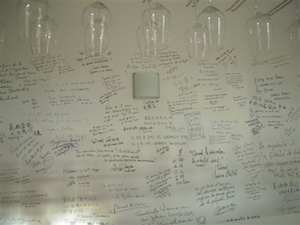 We entered a very modest room with a stainless steel topped table where the tasting would occur. White plaster walls surrounded us, except for one section of high windows for natural lighting. On the entry door wall, there were numerous signatures. Didier told me that it was his way of collecting autographs of all the notable wine critics who had visited his facility. And, the above referenced names were prominently displayed. Knowing full-well that mine did not deserve to be up there, I did not even ask. We tasted some of their second label wines first, and then proceeded into samples of the 2009 and 2010 Leoville Poyferré. The final two were bold expressions of the vine (requiring years before consumption) and very likely bell-ringers which would bring much deserved praise to the name. Didier talked a bit about the closeness of all the Leoville properties and their rivalries over the years. After the tasting concluded, we exited the room, walked down the hall and he shook my hand again before entering his office for the “real start” to his day. It had been a privilege to command that kind of attention.
We entered a very modest room with a stainless steel topped table where the tasting would occur. White plaster walls surrounded us, except for one section of high windows for natural lighting. On the entry door wall, there were numerous signatures. Didier told me that it was his way of collecting autographs of all the notable wine critics who had visited his facility. And, the above referenced names were prominently displayed. Knowing full-well that mine did not deserve to be up there, I did not even ask. We tasted some of their second label wines first, and then proceeded into samples of the 2009 and 2010 Leoville Poyferré. The final two were bold expressions of the vine (requiring years before consumption) and very likely bell-ringers which would bring much deserved praise to the name. Didier talked a bit about the closeness of all the Leoville properties and their rivalries over the years. After the tasting concluded, we exited the room, walked down the hall and he shook my hand again before entering his office for the “real start” to his day. It had been a privilege to command that kind of attention.
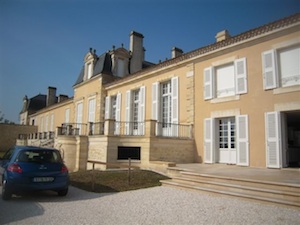 My next stop, Chateau Leoville Las Cases, was a short stroll down the main street of Beychevelle, the St.-Julien community which was home to all the Leoville properties. Of all these sister-wineries, Las Cases was the most impressive. In the opinion of many current day wine scholars, it is the one which now most-deserves to graduate into the realm of the first-growths. The Chateau structure is now utilized for offices, but was originally constructed, facing the Gironde estuary, possibly as a residence of the heirs of Marquis de Las-Cases-Beauvoir. Las Cases remained in the Marquis’ family control until a minor share holder, André Delon inherited shares of the estate from his father, who had purchased them from disinterested heirs of the Marquis. As time passed, he and his descendents continued acquiring shares until majority ownership and control was secured. Such remains the condition at present date. Current St.-Julien property (alone) under-vine is 98 hectares, with similar percentages of varietals as its little sister’s noted above. All of their labels (St.-Julien, Medoc and Pomerol vineyards) produce 450 thousand bottles a year.
My next stop, Chateau Leoville Las Cases, was a short stroll down the main street of Beychevelle, the St.-Julien community which was home to all the Leoville properties. Of all these sister-wineries, Las Cases was the most impressive. In the opinion of many current day wine scholars, it is the one which now most-deserves to graduate into the realm of the first-growths. The Chateau structure is now utilized for offices, but was originally constructed, facing the Gironde estuary, possibly as a residence of the heirs of Marquis de Las-Cases-Beauvoir. Las Cases remained in the Marquis’ family control until a minor share holder, André Delon inherited shares of the estate from his father, who had purchased them from disinterested heirs of the Marquis. As time passed, he and his descendents continued acquiring shares until majority ownership and control was secured. Such remains the condition at present date. Current St.-Julien property (alone) under-vine is 98 hectares, with similar percentages of varietals as its little sister’s noted above. All of their labels (St.-Julien, Medoc and Pomerol vineyards) produce 450 thousand bottles a year.
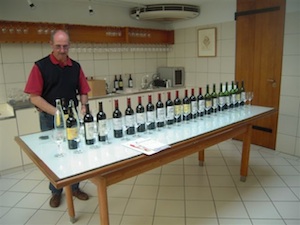 My private guide through the winery was Cellar Master, Bruno ROLLAND. Again, I was the only visitor scheduled for this guided tour and tasting. Bruno took me through their winery equipment chambers (combining the utilization of wooden, stainless steel and concrete vats) and the impressive air-conditioned storage facilities. He then pointed the way to a tasting room which appeared to be more like a laboratory than a showplace designed to impress visitors. Thus, I sensed there are not many “regular-Joes” who are invited for visits. This impression was bolstered when we entered, confronting no less than 20 different wines awaiting my tasting, with separate sparkling clean glasses in front of each bottle, just for “little-ole-me.” And, I tasted them all. Of course, there was very little consumption and a boatload of spitting. I had my almonds along for palate cleansing along with the water they provided. They had multiple vintages from all three districts. Most of what I tasted, some noteworthy, I would never see back at home. However, the best was saved for last. The treat of the morning was my taste of the 2008 Las Cases, which did not require the long-termed aging of many to show its true colors….most impressive. It was as ready for consumption as the Smith-Haut-Lafitte sample I had tasted on the first day. The fruit was large and the character, simply stated, an expression of love.
My private guide through the winery was Cellar Master, Bruno ROLLAND. Again, I was the only visitor scheduled for this guided tour and tasting. Bruno took me through their winery equipment chambers (combining the utilization of wooden, stainless steel and concrete vats) and the impressive air-conditioned storage facilities. He then pointed the way to a tasting room which appeared to be more like a laboratory than a showplace designed to impress visitors. Thus, I sensed there are not many “regular-Joes” who are invited for visits. This impression was bolstered when we entered, confronting no less than 20 different wines awaiting my tasting, with separate sparkling clean glasses in front of each bottle, just for “little-ole-me.” And, I tasted them all. Of course, there was very little consumption and a boatload of spitting. I had my almonds along for palate cleansing along with the water they provided. They had multiple vintages from all three districts. Most of what I tasted, some noteworthy, I would never see back at home. However, the best was saved for last. The treat of the morning was my taste of the 2008 Las Cases, which did not require the long-termed aging of many to show its true colors….most impressive. It was as ready for consumption as the Smith-Haut-Lafitte sample I had tasted on the first day. The fruit was large and the character, simply stated, an expression of love.
As we concluded our visit, Bruno asked me if I wished to tour the vineyards. Regretfully, I did not have the time before the first of my two afternoon adventures commenced. One would be the final Leoville sister property and the other would be my second first-growth estate, the most famous label of them all. Watch for my next chapter which Sally should be posting soon.
Chateau Leoville Poyferré
www.leoville-poyferre.fr
Chateau Leoville Las Cases
www.leoville-las-cases.com
Note: This information was accurate when it was published. Please be sure to confirm all rates and details directly with the businesses in question before making your plans.



